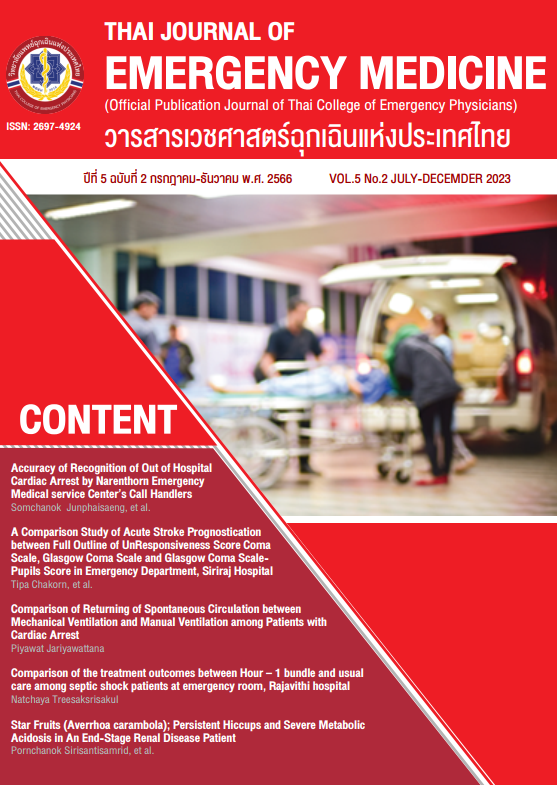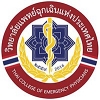Comparison of the treatment outcomes between Hour – 1 Bundle and usual care among septic shock patients at Emergency Room, Rajavithi hospital
Keywords:
Sepsis, Septic shock, Surviving sepsis campaign, Hour-1 bundle, MortalityAbstract
Background Sepsis and septic shock stand as a preeminent medical emergency, wherein prompt and accurate initial interventions within the critical early hours have demonstrated potential for enhancing patient outcomes. The Hour-1 Bundle has garnered endorsement within the recent iteration of the Surviving Sepsis Campaign. However, no statistical evidence regarding the mortality rate of patients when using Hour-1 Bundle for treating sepsis.
Objectives A comparative analysis of 28-day mortality among patients diagnosed with septic shock admitted to the emergency department of Rajavithi hospital: A study of the Hour-1 Bundle care versus usual care cohorts.
Methods A retrospective observational cohort study of septic patients from January to December 2018 for usual care, and from January to December 2022 for patients managed in accordance with the Hour-1 bundle protocol.
Results Enroll 300 patients who diagnosed sepsis shock categorized into two distinct groups: the Hour-1 bundle group (N=149) and the usual care group (N=151). The 28-day mortality is 97 out of 151 patients (64.23%) within the usual care group, and 70 out of 149 patients (46.62%) within the Hour-1 bundle group (P=0.003; OR 2.03; 95%CI 1.28 – 3.22). An expeditious resolution of shock within the initial hour of admission was notable in the Hour-1 bundle group with 119 out of 149 patients (79.86%) in contrast, the usual care group saw 25 out of 151 patients (16.56%) achieving such prompt resolution (P<0.001 ; OR 19.99 ; 95%CI 11.11 – 35.95).
Conclusion The implementation of the Hour-1 bundle protocol in septic shock patients demonstrated a discernible enhancement in the rates of 28-day mortality as well as success shock resuscitation within the initial hour.
References
Strategy and Planning Division, Office of the Permanent Secretary Ministry of Public Health. Details of Key performance indicators from the Ministry of Public Health fiscal year 2023:120-3.
Levy MM, Evans LE, Rhodes A. The surviving sepsis campaign bundle: 2018 update: 2018 Update. Crit Care Med. 2018;46(6):997–1000.
Ko BS, Choi SH, Shin TG, Kim K, Jo YH, Ryoo SM, et al. Impact of 1-hour bundle achievement in septic shock. JClin Med. 2021; 10(3): 527.
Singer M, Deutschman CS, Seymour CW, Shankar-Hari M, Annane D, Bauer M, et al. The third international consensus definitions for sepsis and septic shock (sepsis-3). JAMA. 2016;315(8):801–10.
Knaus WA, Draper EA, Wagner DP, Zimmerman JE. APACHE II: a severity of disease classification system. Crit Care Med. 1985;13(10):818–29.
Jansen TC, van Bommel J, Schoonderbeek FJ, Sleeswijk Visser SJ, van der Klooster JM, Lima AP, et al. Early lactate-guided therapy in intensive care unit patients: a multicenter, open-label, randomized controlled trial: A multicenter, open-label, randomized controlled trial. Am J Respir Crit Care Med. 2010;182(6):752–61.
Jones AE, Shapiro NI, Trzeciak S, Arnold RC, Claremont HA, Kline JA, et al. Lactate clearance vs central venous oxygen saturation as goals of early sepsis therapy: a randomized clinical trial. JAMA. 2010; 303(8):739–46.
Puskarich MA, Trzeciak S, Shapiro NI, Arnold RC, Heffner AC, Kline JA, et al. Prognostic value and agreement of achieving lactate clearance or central venous oxygen saturation goals during early sepsis resuscitation: Goals of early sepsis resuscitation. Acad Emerg Med. 2012;19(3):252–8.
Casserly B, Phillips GS, Schorr C, Dellinger RP, Townsend SR, Osborn TM, et al. Lactate measurements in sepsis-induced tissue hypoperfusion: results from the Surviving Sepsis Campaign database. Crit Care Med. 2015;43(3):567–73.
Dettmer M, Holthaus CV, Fuller BM. The impact of serial lactate monitoring on emergency department resuscitation interventions and clinical outcomes in severe sepsis and septic shock: an observational cohort study: An observational cohort study. Shock. 2015;43(1):55–61.
Ryoo SM, Lee J, Lee Y-S, Lee JH, Lim KS, Huh JW, et al. Lactate level versus lactate clearance for predicting mortality in patients with septic shock defined by sepsis-3. Crit Care Med. 2018;46(6):e489–95.
Arnold RC, Shapiro NI, Jones AE, Schorr C, Pope J, Casner E, et al. Multicenter study of early lactate clearance as a determinant of survival in patients with presumed sepsis. Shock. 2009;32(1):35–9.
Puskarich MA, Trzeciak S, Shapiro NI, Albers AB, Heffner AC, Kline JA, et al. Whole blood lactate kinetics in patients undergoing quantitative resuscitation for severe sepsis and septic shock. Chest. 2013;143(6):1548–53.
Kramer A, Urban N, Döll S, Hartwig T, Yahiaoui-Doktor M, Burkhardt R, et al. Early lactate dynamics in critically ill non-traumatic patients in a resuscitation room of a German emergency department (OBSERvE-lactate-study). J Emerg Med. 2019;56(2):135–44.
Jansen TC, van Bommel J, Woodward R, Mulder PGH, Bakker J. Association between blood lactate levels, Sequential Organ Failure Assessment subscores, and 28-day mortality during early and late intensive care unit stay: A retrospective observational study. Crit Care Med. 2009;37(8):2369–74.
Umemura Y, Abe T, Ogura H, Fujishima S, et al. Hour-1 bundle adherence was associated with reduction of in-hospital mortality among patients with sepsis in Japan. PLoS ONE 2022;17(2).
Rivers E, Nguyen B, Havstad S, Ressler J, Muzzin A, Knoblich B, et al. Early goaldirected therapy in the treatment of severe sepsis and septic shock. N Engl J Med. 2001;345(19):1368–77.
Ferrer R, Martin-Loeches I, Phillips G, Osborn TM, Townsend S, Dellinger RP, et al. Empiric antibiotic treatment reduces mortality in severe sepsis and septic shock from the first hour: Results from a guideline-based performance improvement program. Crit Care Med. 2014;42(8):1749–55.
Bai X, Yu W, Ji W, Lin Z, Tan S, Duan K, et al. Early versus delayed administration of norepinephrine in patients with septic shock. Crit Care. 2014;18(5):532.
Permpikul C, Tongyoo S, Viarasilpa T, Trainarongsakul T, Chakorn T, Udompanturak S. Early use of norepinephrine in septic shock resuscitation (CENSER). A randomized trial. Am J Respir Crit Care Med. 2019;199(9):1097–105.
The ProCESS Investigators. A randomized trial of protocol-based care for early septic shock. N Engl J Med. 2014;370(18):1683–93.
ARISE Investigators, ANZICS Clinical Trials Group, Peake SL, Delaney A, Bailey M, Bellomo R, et al. Goal-directed resuscitation for patients with early septic shock. N Engl J Med. 2014;371(16):1496–506.
Mouncey PR, Osborn TM, Power GS, Harrison DA, Sadique MZ, Grieve RD, et al. Trial of early, goal-directed resuscitation for septic shock. N Engl J Med. 2015;372(14):1301–11.
The Strengthening the Reporting of Observational Studies in Epidemiology (STROBE) Statement: Guidelines for Reporting Observational Studies. November 2007BMJ 335(7624):806-8.
Downloads
Published
How to Cite
License
Copyright (c) 2024 Thai Collage of Emergency Physicians

This work is licensed under a Creative Commons Attribution-NonCommercial-NoDerivatives 4.0 International License.
บทความที่ได้รับตีพิมพ์ในวารสารเวชศาสตร์ฉุกเฉินแห่งประเทศไทย ถือเป็นเป็นลิขสิทธิ์ของ วิทยาลัยแพทย์เวชศาสตร์ฉุกเฉินแห่งประเทศไทย
กรณีที่บทความได้รับการตีพิมพ์ในวารสารเวชศาสตร์ฉุกเฉินแห่งประเทศไทยแล้ว จะตีพิมพ์ในรูปแบบอิเล็กทรอนิกส์ ไม่มีสำเนาการพิมพ์ภายหลังหนังสือเผยแพร่เรียบร้อยแล้ว ผู้นิพนธ์ไม่สามารถนำบทความดังกล่าวไปนำเสนอหรือตีพิมพ์ในรูปแบบใดๆ ที่อื่นได้ หากมิได้รับคำอนุญาตจากวารสารเวชศาสตร์ฉุกเฉินแห่งประเทศไทย




